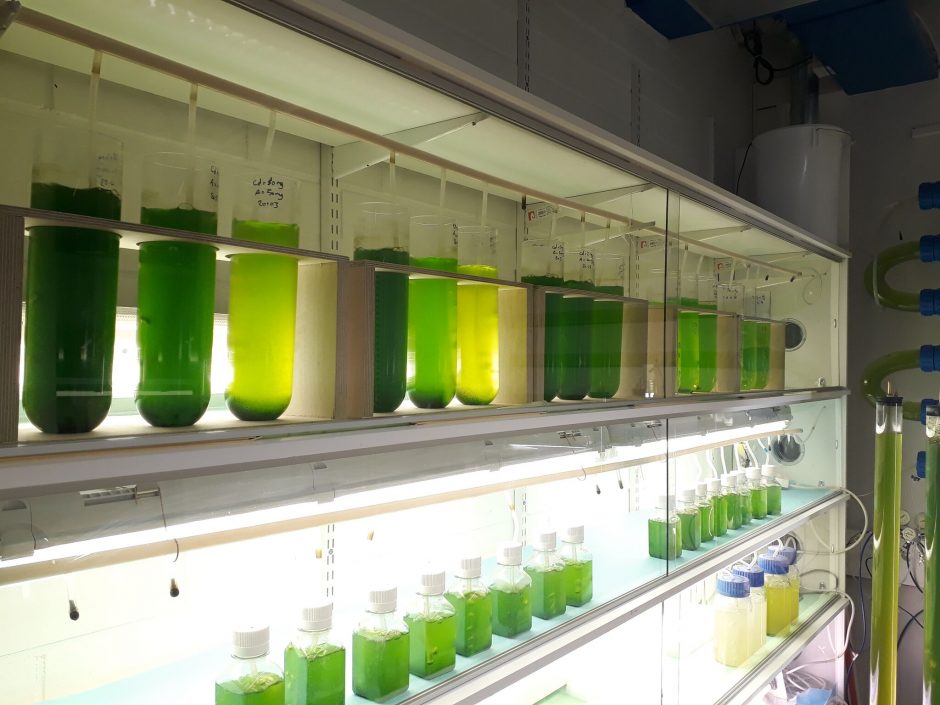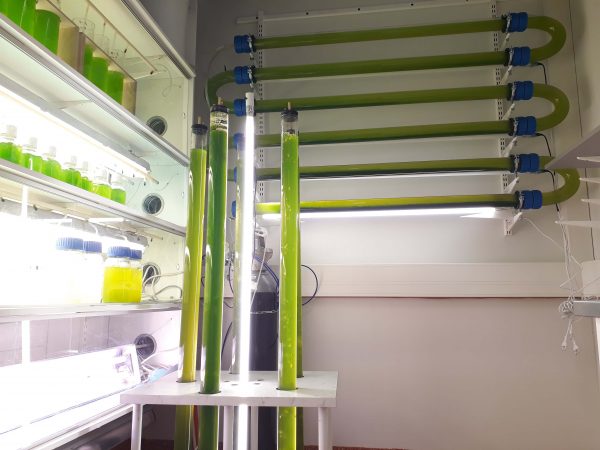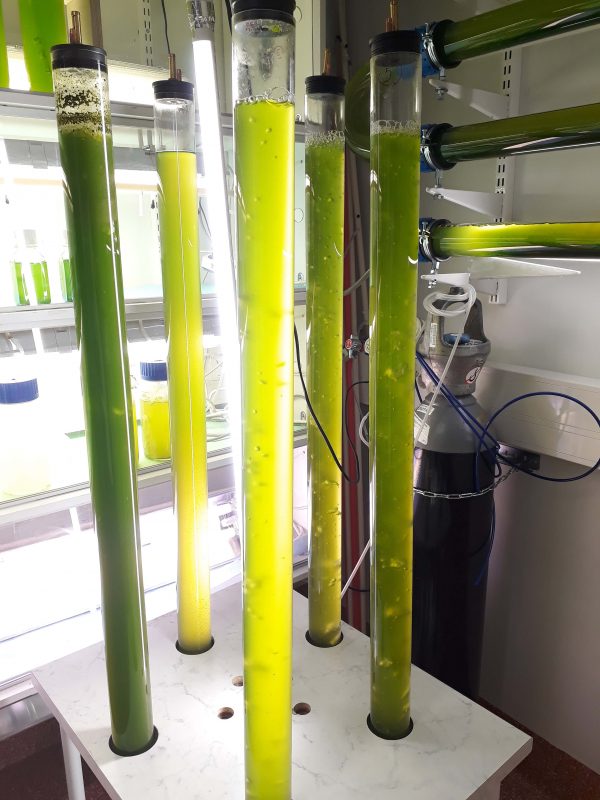Treating Wastewater and Producing Clean Energy with Microalgae

(Photo credit: Dr. Amit Bhatnagar, University of Eastern Finland, via communication)
On a planet that feels a little smaller every day, scientists are always looking for sustainable sources of food, low-impact and low-cost ways to produce clean water, pollution mitigation strategies, and sources of clean energy. Researchers from University of Eastern Finland have recently found a solution to multiple problems in using Chlorella vulgaris, a universal freshwater microalga.
Exploring the uses of microalgae
“Wastewater treatment is energy demanding and requires the use of expensive toxic chemicals, which cause secondary pollution,” explains University of Eastern Finland Associate Professor of Water Chemistry Amit Bhatnagar. “Although wastewater treatment using microalgae is a proven eco-friendly solution, sometimes microalgae cannot grow well in wastewater due to low or high concentrations of certain nutrients or high concentrations of pollutants. Thus, this technology first requires proper optimization to achieve the best results.”
That’s exactly what the team set out to do with this work, with the aim of making C. vulgaris a meaningful treatment option. According to Prof. Bhatnagar, the paper and pulp industries are important to Finland’s economy; this means that the pulp industry is the third largest producer by volume of wastewater, a byproduct that can harm both the environment and human health.
Paper and pulp wastewater, in particular, is carbon-rich but nitrogen and phosphorus poor. Nitrogen and phosphorus are nutrients that microalgae must have to grow, so the team had a problem to solve as they began.
“The requirement for nutrients can be achieved by adding other wastewater which is rich in nutrients (such as aquaculture wastewater), thus offering the possibility of microalgae cultivation in industrial wastewaters without the addition of macro and micronutrients to the algal medium,” details Ehsan Daneshvar, PhD student in Prof. Bhatnagar’s research group. “Thus, this approach offers eco-friendly, low-cost and effective wastewater treatment and subsequent production of value-added products from microalgal biomass.”

(Photo credit: Dr. Amit Bhatnagar, University of Eastern Finland, via communication)
The next question: which species of microalgae? The team chose to trial C. vulgaris for several reasons.
“Chlorella vulgaris is a universal freshwater microalga,” Prof. Bhatnagar describes. “This microalga can tolerate different environmental conditions and grows fast. Cultivation of C. vulgaris, even in high volumes of wastewater, is easy. Finally, C. vulgaris can grow very well in different types of wastewaters, which have low salinity.”
Putting C. vulgaris to the test
The team conducted the trials in three main phases. In the experiment’s first step, the team used local lake water (LW), aquaculture wastewater (AW), pulp wastewater (PW), and mixtures of pulp wastewater and lake water (PWLW) and pulp wastewater and aquaculture wastewater (PWAW); the three types of water with different ratios, instead of deionized water, to prepare the microalgal medium. This allowed the researchers to select experimental units with the highest algal growth during the experiment’s second phase, and use them to evaluate the feasibility of C. vulgaris cultivation both with and without the addition of macro and micronutrients.
Next, the team evaluated wastewater treatment after optimizing the growth conditions. Finally, they analyzed biochemical compositions and fatty acid methyl esters (FAMEs) to evaluate how effectively the microalga produced bioenergy.
The team found that the best ratios of PW to AW (or PWAW) were 80:20 and 60:40 for culturing the microalga. The highest dry algal weight without adding micronutrients was 1.31 g/L in 60% PW:40% AW. When the team reviewed how efficiently the microalga removed nutrients and organic compounds, they determined that C. vulgaris has the potential for PWAW treatment and accumulation of carbohydrates and lipids. This was true for any wastewater containing enough of the right nutrients.
“Generally, wastewaters containing higher concentrations of nutrients (nitrogen and phosphorus) are highly suitable for the cultivation of C. vulgaris and other microalgae species,” remarks Prof. Bhatnagar. “Examples include municipal wastewater, aquaculture wastewater, livestock wastewater, dairy wastewater and agriculture wastewater.”
However, Prof. Bhatnagar cautions that although microalgae can tolerate harsh wastewater environments, in most cases microalgae cannot be cultivated directly in the wastewater. This is because wastewater usually contains very high concentrations of toxic compounds, such as dyes, heavy metals, and pharmaceuticals. This only means that the microalga works best under optimized conditions, such as mixing the right kinds of wastewater or diluting them for better cultivation conditions.

(Photo credit: Dr. Amit Bhatnagar, University of Eastern Finland, via communication)
The future of microalga treating our water
Right now, microalgae like C. vulgaris are already part of wastewater treatment in some countries, including some places in the United States. However, if the team is able to further optimize their system, it may be used more frequently in the future—especially since it really addresses at least two important issues.
“Clean water and energy supply are two important challenges of the 21st century,” states Prof. Bhatnagar. “Microalgae can address both these issues. Nitrogen and phosphorus compounds (sources of eutrophication in the environment), among other macro and micronutrients, are considered as the main fertilizers for the cultivation of microalgae. As microalgae grow in wastewater by using these nutrients, the concentrations of these will be decreased and the produced microalgal biomass can be used further to produce bioenergy. Biodiesel (from lipids), bioethanol (from starches) and biogas are the main bioenergy products which can be obtained from the microalgae.”
The team is primarily working to adapt this technology for wastewater treatment and for recovering resources such as bioenergy, metals, and nutrients from water and wastewater. They also plan to develop bio-based products from microalgae for different applications. Although there are no consumer applications envisioned as yet, the main stakeholders of this technology—including wastewater treatment plants, bioenergy companies, and the aviation and biotechnology industries—given the range of uses here the team is likely to be busy. Furthermore, microalgae-based technologies generally already have a number of consumer applications, so the full potential of this research will unfold over time.
“Microalgae can help in combating various global challenges including climate change, food insecurity, wastewater management, and more,” adds Prof. Bhatnagar. “Moreover, microalgae is a sustainable food and fuel source for the future.”
Top image: Treating wastewater with microalgae (Credit: Dr. Amit Bhatnagar, University of Eastern Finland, via communication)




0 comments